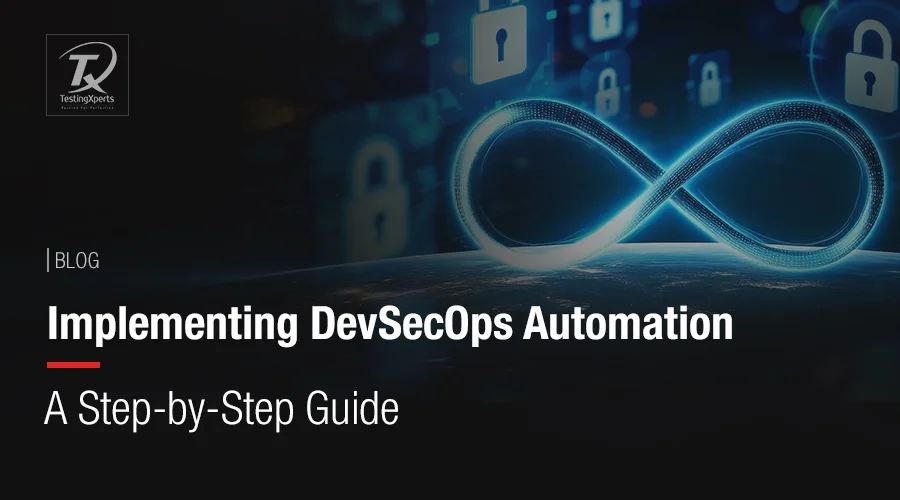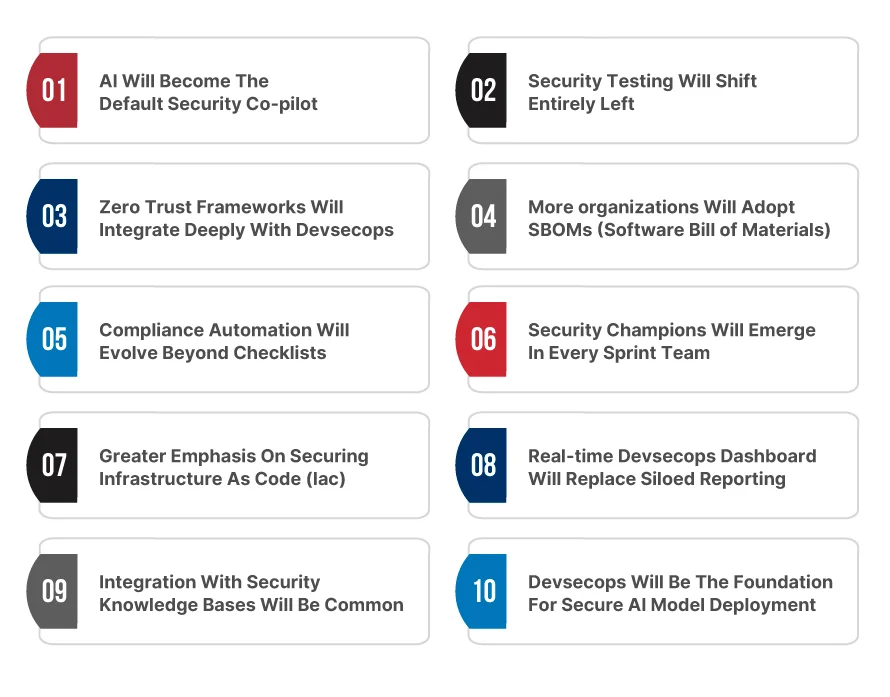Recommended Blogs
Implementing DevSecOps Automation: A Step-by-Step Guide

- What is DevSecOps Automation?
- Why DevSecOps Matters in 2025?
- Top DevSecOps Automation Tools
- AI Integration in DevSecOps
- Security in CI/CD Pipelines
- Compliance & Governance Automation
- Real-World Case Study
- Conclusion
DevOps has completely changed how businesses approach their IT operations and work towards innovation. It assists them in designing, developing, and delivering products/services at a much faster scale. However, during this shift, business leaders realized that traditional security measures and manual controls relying on legacy methods could not keep up with high-paced, continuous delivery software development. And this is true. DevOps has struggled for a long time with security integration, creating risky trade-offs between business agility and digital resilience. That’s why DevSecOps seeks to resolve this issue by integrating security throughout the software development lifecycle (SDLC).
DevSecOps enables businesses to address security issues before they get pushed into production, making bugs much easier and cheaper to fix. This also means that making the product safer and bug-free will be the shared responsibility of the development, testing, IT operations, and security teams. However, for DevSecOps to be effective, businesses need to automate it. DevSecOps automation would allow the operations team, developers, testers, and security engineers to scale SDLC collectively regardless of the production environment (public, private, on-premises, or hybrid cloud).
What is DevSecOps Automation?
DevSecOps automation involves automating and integrating security processes into the SDLC pipeline. Teams use various tools, frameworks, and technologies to automate security controls, thus streamlining testing and compliance checks. This allows businesses to manage security without human bottlenecks and promotes cross-team communication and skill development. In a study, it was analyzed that:
17% of organizations were still in the exploratory and proof-of-concept stage in the DevSecOps implementation
86% of organizations faced challenges with their current security approach, and 51% claimed they were unable to decipher how security fits into DevSecOps
71% stated that cultural difference was the biggest obstacle in their DevSecOps progress
Why DevSecOps Matters in 2025?
Sometimes, businesses eliminate the security check to speed up the deployment process in the production environment. With DevSecOps automation, they no longer have to sacrifice security for speed while eliminating manual involvement in checking software vulnerabilities. This enables teams to focus on other priority tasks to deliver higher business value. It also improves visibility and observability across SDLC and assists teams in identifying vulnerabilities’ root causes and designing action plans accordingly.
Top 10 Predictions for DevSecOps Automation
-
AI Will Become The Default Security Co-pilot
AI will assist in real-time threat detection, anomaly spotting, and even automated patching. It won’t replace engineers but will amplify their efficiency.
-
Security Testing Will Shift Entirely Left
Expect security to become a priority from the first line of code, not the final deployment stage. Integrated DevSecOps pipelines will make this seamless.
-
Zero Trust Frameworks Will Integrate Deeply With Devsecops
With growing threats across supply chains and open-source tools, Zero Trust will become a non-negotiable part of automation frameworks.
-
More organizations Will Adopt SBOMs (Software Bill of Materials)
Driven by regulatory demands like those from the US government, SBOMs will become a DevSecOps standard for component tracking and risk analysis.
-
Compliance Automation Will Evolve Beyond Checklists
Compliance won’t just be a tick-box task. Intelligent tools will enforce and validate standards in real time during development.
-
Security Champions Will Emerge In Every Sprint Team
Security won’t sit in a silo. Dev teams will appoint in-sprint security advocates to ensure secure coding and testing practices.
-
Greater Emphasis On Securing Infrastructure As Code (Iac)
IaC automation will include embedded checks to detect misconfigurations, privilege escalations, and policy violations before deployment.
-
Real-time DevSecops Dashboards Will Replace Siloed Reporting
Unified, role-based dashboards will offer live visibility across code, security, compliance, and performance—accessible to everyone, from testers to the CISO.
-
Integration With Security Knowledge Bases Will Be Common
Tools will pull insights directly from sources like OWASP, NIST, and GitHub Security Advisories to detect and address known risks.
-
Devsecops Will Be The Foundation For Secure AI Model Deployment
With generative AI in production, teams will treat AI models like software artifacts. DevSecOps will ensure responsible testing, governance, and secure model releases.
Top DevSecOps Automation Tools
Here are 13 tools businesses are actively using in 2025 to build automated, secure, and scalable DevSecOps pipelines:
-
GitLab Ultimate:
Offers built-in security testing, SAST, DAST, container scanning, and license compliance in CI/CD workflows.
-
Jenkins with OWASP Dependency-Check Plugin:
Extends Jenkins to scan for vulnerable dependencies using OWASP intelligence.
-
Aqua Security:
Specializes in container security, Kubernetes workload protection, and cloud-native runtime defense.
-
Snyk:
Scans open-source dependencies, containers, and Infrastructure as Code for known vulnerabilities. Integrates well with GitHub and GitLab.
-
Checkmarx:
Focused on static application security testing (SAST) with deep code analysis and support for over 30 programming languages.
-
SonarQube:
Known for quality gates and static code analysis. With plugins, it supports vulnerability scanning and secure coding practices.
-
Palo Alto Prisma Cloud:
Provides full lifecycle security across cloud workloads, APIs, and infrastructure.
-
HashiCorp Vault:
Manages secrets, encryption keys, and sensitive data access across multi-cloud environments.
-
Fortify by OpenText:
Delivers both static and dynamic testing, used by enterprises for deep policy-based governance.
-
Veracode:
Offers SaaS-based application security, with centralized policy management and integrations across SDLC tools.
-
Anchore:
Focuses on container image scanning and policy enforcement, especially in Docker and Kubernetes environments.
-
Burp Suite Enterprise:
Automates dynamic application security testing (DAST) at scale, perfect for staging and production readiness.
-
Trivy:
An open-source vulnerability scanner for containers and repositories, widely used in cloud-native DevSecOps setups.
These tools help automate security scanning, manage vulnerabilities, enforce policies, and maintain governance without slowing down development cycles.
AI Integration in DevSecOps
AI is making DevSecOps faster, smarter, and more proactive. Here’s how:
- Faster Threat Detection: AI spots hidden risks in logs and behavior patterns before they become breaches.
- Smarter Prioritization: It ranks vulnerabilities based on real impact, not just severity scores.
- Secure Coding Suggestions: NLP-based tools scan code and recommend fixes as developers write.
- Automated Test Case Generation: AI adjusts test cases in real time as code changes.
- Live Compliance Checks: AI predicts violations before audits and flags risky changes early.
- Built-in Threat Intelligence: Tools tap into OWASP, NIST, and GitHub for up-to-date attack insights.
Security in CI/CD Pipelines
Security needs to move at the same pace as your code. In modern CI/CD pipelines, that means:
- Embed security checks at every stage from code commit to deployment
- Use tools like SAST, DAST, and IaC scanners for early detection and continuous validation
- Automate secrets management to avoid hardcoded credentials or access leaks
- Set up gatekeeping policies block builds that fail security benchmarks
- Enable real-time alerts and rollbacks to respond instantly without halting delivery
When security becomes a built-in step, not a final check, you get faster releases without compromising protection.
Compliance & Governance Automation
- Manual compliance slows everything down. Automation solves that by:
- Auto-checking code and configs against standards like OWASP and NIST
- Generating audit trails in real time across builds, tests, and deployments
- Enforcing policies with pre-approved templates and guardrails
- Mapping risks to regulations like HIPAA, GDPR, and PCI-DSS
- Cutting human error from reviews and documentation
With automation, compliance becomes a built-in outcome, not a time-consuming tas
Conclusion
DevSecOps automation is no longer optional. It’s the backbone of building secure, reliable, and scalable software at speed. By embedding security into every phase of the development lifecycle, businesses can reduce risks without slowing innovation.
Looking ahead, expect DevSecOps to evolve with smarter AI models, deeper cloud-native integrations, and stronger compliance automation. Teams that adopt it early will gain a competitive edge—not just in faster releases, but in trust, quality, and resilience.
At Tx, our experts help you build a secure-by-default culture through DevSecOps automation, real-time monitoring, and AI-powered insights. Let’s make security a strength, not a speed bump.
FAQs
The four key components of DevSecOps are secure code development, continuous integration and continuous delivery (CI/CD), security as code, and continuous monitoring.
The three pillars of DevSecOps are people, processes, and technology. People involve training teams to adopt a security-first mindset. Processes include integrating security practices seamlessly into the software development lifecycle (SDLC). Technology leverages tools and automation to implement and enforce security measures efficiently.
DevSecOps is not an SDLC but a practice that integrates security into every stage of the SDLC. It upscales traditional software development by integrating security into workflows, automating security tasks, and ensuring continuous protection without disrupting delivery timelines.
DevSecOps Automation automates security through vulnerability scanning, code analysis, and compliance checks. It reduces human error and improves efficiency in CI/CD pipelines. It ensures faster and more consistent delivery of secure applications while enhancing incident response through automated threat detection and mitigation.
Discover more
Stay Updated
Subscribe for more info


